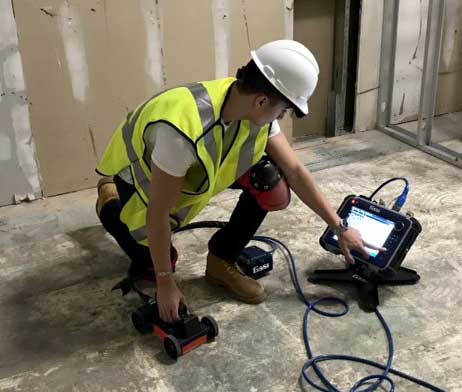RainierGPR Concrete Scanning: Advanced Solutions for Safe Construction
RainierGPR Concrete Scanning: Advanced Solutions for Safe Construction
Blog Article
Checking Out the Secret Benefits of Concrete Scanning in Building Projects
In the world of modern building and construction practices, the usage of concrete scanning technology has arised as a pivotal tool for guaranteeing task performance and structural stability. From enhancing safety steps to precisely identifying utilities concealed under the surface, the advantages of concrete scanning are complex. RainierGPR Concrete Scanning.
Enhanced Precaution
Making use of sophisticated concrete scanning innovation boosts security procedures on building sites by providing exact discovery of prospective threats hidden underneath the surface. This innovation allows building groups to recognize rebar, conduits, post-tension cable televisions, and other obstructions prior to excavation or drilling, substantially reducing the threat of accidents. By identifying these aspects precisely, workers can prevent destructive essential architectural components, thus protecting against injuries, delays, and expensive fixings.
Additionally, concrete scanning plays a vital role in making sure the stability of existing frameworks throughout renovations or expansions. By spotting weak points, spaces, or degeneration within concrete elements, designers can deal with these problems proactively, improving the general security and longevity of the structure. This positive approach not only alleviates the threat of architectural failings but likewise decreases the possibility for accidents triggered by unpredicted architectural deficiencies.
Essentially, the application of concrete scanning modern technology acts as a positive precaution that safeguards both building employees and the architectural honesty of buildings, ultimately adding to the general success and efficiency of construction projects. - RainierGPR Concrete Scanning
Accurate Detection of Utilities
Concrete scanning modern technology helps with precise recognition of underground utilities, enhancing building and construction website safety and security and efficiency. Exact detection of energies is important in building and construction tasks to prevent pricey damages, job delays, and most significantly, make certain the safety and security of workers and the general public. By making use of sophisticated scanning technologies such as ground-penetrating radar (GPR) and electro-magnetic induction, construction groups can draw up the place of hidden pipes, wires, and various other energies with high levels of precision.

Time and Cost Performance
Concrete scanning technology enables building groups to precisely locate rebar, post-tension wires, and various other ingrained items within concrete structures. This specific details helps in preventing expensive errors such as accidental damage to critical aspects during drilling, cutting, or coring tasks. Furthermore, by recognizing possible risks in advance, the demand for expensive repairs or revamp because of problems can be decreased, causing cost financial savings for the job.

Furthermore, the capability to quickly and accurately detect energies underneath the surface area without triggering any kind of damage not only conserves time but also stops expensive disruptions to existing framework. Generally, the time and price effectiveness benefits of concrete scanning make it an invaluable tool for boosting construction task monitoring and implementation.
Conservation of Structural Stability
Protecting the structural stability of buildings and infrastructure is extremely important in making certain long-term stability and security. Concrete scanning plays an essential function in this preservation process by enabling building specialists to determine potential dangers to the structural honesty of a structure or facilities before they escalate into significant issues. Via the usage of sophisticated scanning innovations such as ground-penetrating radar (GPR) and electro-magnetic induction, building groups can non-invasively assess the problem of concrete frameworks, situate rebar, post-tension wires, and various other embedded elements, and determine any gaps, cracks, or deterioration within the concrete.
Improved Job Planning
In order to guarantee the effective implementation of building jobs, meticulous interest to information and detailed planning are important components that come from an extensive understanding of the architectural problems identified with concrete scanning. Improved job preparation, assisted in by concrete scanning, permits construction teams to preemptively resolve prospective obstacles, allot resources a lot more effectively, and develop reasonable timelines. By properly identifying the area of rebar, post-tension cable televisions, and various other ingrained things within concrete frameworks, job managers can create much more exact building plans that minimize the risk of pricey errors or hold-ups. Additionally, the information acquired from concrete scanning makes it possible for stakeholders to make enlightened choices relating to architectural alterations, improvements, or growths, bring about smoother task shifts and improved overall job outcomes. Inevitably, including concrete my blog scanning into the task preparation phase boosts coordination among group participants, cultivates proactive analytic, and adds to the successful shipment of building jobs within budget and schedule restraints.
Verdict
Finally, concrete scanning supplies many advantages get redirected here in building projects. By boosting safety actions, accurately spotting energies, improving time and cost performance, preserving architectural stability, and aiding in task preparation, concrete scanning proves to be an essential tool for successful task implementation. Its ability to alleviate risks, raise performance, and guarantee project honesty makes it an indispensable asset for building experts.
In the realm of modern-day building techniques, the use of concrete scanning technology has arised as a crucial tool for guaranteeing project performance and architectural honesty.Concrete scanning technology allows building groups to accurately locate rebar, post-tension cables, and other ingrained things within concrete frameworks. Through the use of innovative scanning innovations such as ground-penetrating radar (GPR) and electro-magnetic induction, building teams can non-invasively evaluate the problem of concrete frameworks, find rebar, post-tension cables, and various other embedded aspects, and determine any kind of voids, cracks, or deterioration within the concrete.
In order to make certain the successful execution of building and construction jobs, thorough focus to information and detailed preparation are necessary parts that stem from a detailed understanding of the architectural conditions determined via concrete scanning. Ultimately, including concrete scanning into the project planning stage improves coordination among group participants, cultivates proactive analytic, and contributes to the useful link successful delivery of construction tasks within budget and routine restraints.
Report this page